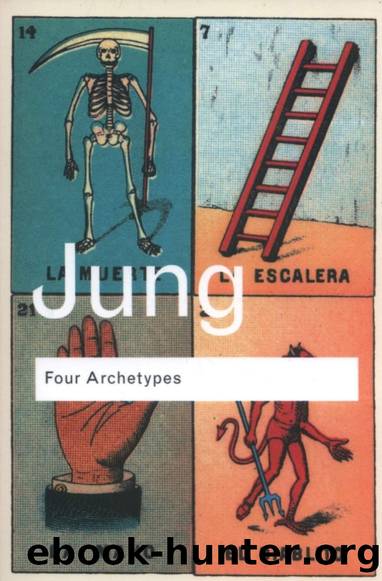Four Archetypes by C.G. Jung

Author:C.G. Jung [Jung, C.G.]
Language: eng
Format: epub
ISBN: 9781400839155
Google: JTpkawswVNoC
Barnesnoble:
Goodreads: 17035551
Publisher: Princeton University Press
Published: 2011-10-15T05:00:00+00:00
II. SELF-REPRESENTATION OF THE SPIRIT IN DREAMS
396
The psychic manifestations of the spirit indicate at once that they are of an archetypal natureâin other words, the phenomenon we call spirit depends on the existence of an autonomous primordial image which is universally present in the preconscious makeup of the human psyche. As usual, I first came up against this problem when investigating the dreams of my patients. It struck me that a certain kind of father-complex has a âspiritualâ character, so to speak, in the sense that the father-image gives rise to statements, actions, tendencies, impulses, opinions, etc., to which one could hardly deny the attribute âspiritual.â In men, a positive father-complex very often produces a certain credulity with regard to authority and a distinct willingness to bow down before all spiritual dogmas and values; while in women, it induces the liveliest spiritual aspirations and interests. In dreams, it is always the father-figure from whom the decisive convictions, prohibitions, and wise counsels emanate. The invisibility of this source is frequently emphasized by the fact that it consists simply of an authoritative voice which passes final judgments.7 Mostly, therefore, it is the figure of a âwise old manâ who symbolizes the spiritual factor. Sometimes the part is played by a ârealâ spirit, namely the ghost of one dead, or, more rarely, by grotesque gnomelike figures or talking animals. The dwarf forms are found, at least in my experience, mainly in women; hence it seems to me logical that in Ernst Barlachâs play Der tote Tag (1912), the gnomelike figure of Steissbart (âRumpbeardâ) is associated with the mother, just as Bes is associated with the mother-goddess at Karnak. In both sexes the spirit can also take the form of a boy or a youth. In women he corresponds to the so-called âpositiveâ animus who indicates the possibility of conscious spiritual effort. In men his meaning is not so simple. He can be positive, in which case he signifies the âhigherâ personality, the self or filius regius as conceived by the alchemists.8 But he can also be negative, and then he signifies the infantile shadow.9 In both cases the boy means some form of spirit.10 Graybeard and boy belong together. The pair of them play a considerable role in alchemy as symbols of Mercurius.
397
It can never be established with one-hundred-per-cent certainty whether the spirit-figures in dreams are morally good. Very often they show all the signs of duplicity, if not of outright malice. I must emphasize, however, that the grand plan on which the unconscious life of the psyche is constructed is so inaccessible to our understanding that we can never know what evil may not be necessary in order to produce good by enantiodromia, and what good may very possibly lead to evil. Sometimes the probate spiritus recommended by John cannot, with the best will in the world, be anything other than a cautious and patient waiting to see how things will finally turn out.
398
The figure of the wise old man can appear
Download
This site does not store any files on its server. We only index and link to content provided by other sites. Please contact the content providers to delete copyright contents if any and email us, we'll remove relevant links or contents immediately.
The Art of Thinking Clearly by Rolf Dobelli(10220)
Mindhunter: Inside the FBI's Elite Serial Crime Unit by John E. Douglas & Mark Olshaker(9200)
Change Your Questions, Change Your Life by Marilee Adams(7635)
Nudge - Improving Decisions about Health, Wealth, and Happiness by Thaler Sunstein(7615)
Mastermind: How to Think Like Sherlock Holmes by Maria Konnikova(7227)
The Power of Now: A Guide to Spiritual Enlightenment by Eckhart Tolle(5605)
Men In Love by Nancy Friday(5155)
Altered Sensations by David Pantalony(5045)
Factfulness: Ten Reasons We're Wrong About the World – and Why Things Are Better Than You Think by Hans Rosling(4694)
The Confidence Code by Katty Kay(4187)
Thinking in Bets by Annie Duke(4152)
Man and His Symbols by Carl Gustav Jung(4067)
The Worm at the Core by Sheldon Solomon(3435)
Why Buddhism is True by Robert Wright(3404)
Liar's Poker by Michael Lewis(3369)
Three Women by Lisa Taddeo(3354)
The Inner Life of Animals by Peter Wohlleben(3259)
Descartes' Error by Antonio Damasio(3230)
How Music Works by David Byrne(3186)
